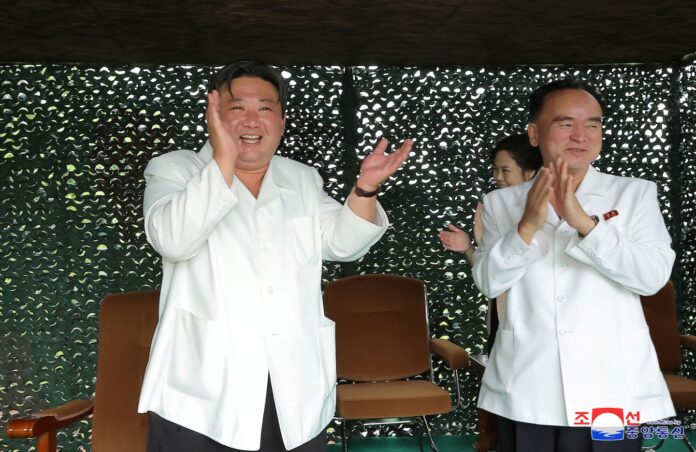“While not without limitations, North Korea has gotten very close to achieving a missile capacity to strike the U.S. mainland,” said Shin Jong-woo, a senior analyst at Seoul-based Korea Defense Security Forum.

To avoid other countries, North Korea launches test missiles at a much higher-than-normal trajectory — nearly straight up — so missiles come down
in the Sea of Japan (East Sea).
Int’l.
Space
Station
orbit:
250
miles
Trajectories shown
are approximate.
Sources: CNS North Korea Missile Testing Database
and Japan Ministry of Defense

To avoid other countries, North Korea launches test missiles at a much higher-than-normal trajectory — nearly straight up — so missiles come down in the Sea of Japan (East Sea).
International Space
Station orbit:
250 miles
Trajectories shown
are approximate.
Sources: CNS North Korea Missile Testing Database and Japan Ministry of Defense
As usual, North Korea aimed for height not distance with the launch to try ensure the missile did not hit land. It traveled about 600 miles, splashing down off the coast of Japan.
“North Korea’s next goal will be firing its ICBM at a normal angle into the Pacific” to demonstrate its ability to send a warhead across the ocean, said Shin.
North Korea’s nuclear and ballistic missile activities are banned under the United Nations Security Council resolutions, which led to the current sanctions regime. The council will hold a public meeting on Thursday to discuss the latest launch.
Kim, the North’s leader, supervised Wednesday’s launch outside Pyongyang and called for “more intense efforts to implement the line of bolstering nuclear war deterrent,” citing security threats by “the hostile forces.” He warned the United States and South Korea that “a series of stronger military offensives” will follow unless the two allies curtail their confrontations, the North’s official Korean Central News Agency reported on Thursday.
North Korean state media said the Hwasong-18 flew as high as 4,131 miles, consistent with Japanese estimates.
If fired on a normal trajectory, it would be capable of traveling more than 8,000 miles, said Shin Seung-ki, a research fellow at the Seoul-based Korea Institute for Defense Analysis, easily reaching the continental United States.
Solid-propellant, made by packing fuel and oxidizer together into a hard mixture, is dense, stable and can be preloaded onto a rocket. This feature enables solid-fuel missiles to be deployed quicker and avoid early detection.
Liquid-propellant, used in North Korea’s older ICBM systems, requires fuel and oxidizer to be loaded on-site ahead of launch, which results in more preparation steps. While liquid fuel provides a greater propulsion than its solid counterpart, the slow-moving preparation can be a major disadvantage in the field. Most countries with ICBM capability, including Russia, China and the United States, maintain a mix of solid and liquid-propelled types.
Firing a Hwasong-18 missile twice was a “notable achievement that underscores North Korea’s prowess in solid-propellant technology,” said Vann H. Van Diepen, a former top nonproliferation official at the State Department.
But it is not surprising given North Korea’s previous efforts and the fact the technology is now 60 years old and used by its allies, Russia and China.
The solid-fuel ICBM has been a priority for Kim, but KCNA referred to the latest launch as “test-fire.” That suggested the North Koreans were not yet ready to declare the Hwasong-18 as operational, Van Diepen said.
The country’s scientists would still have gained useful insights from the test to prepare for a full-range launch, analysts said.
Other than the solid-fuel component, North Korea still has new technologies to test and develop for its ICBM system. Its previous lofted-angle launches did not demonstrate whether the missile can survive a fiery reentry into the earth’s atmosphere.
The next big challenge for Pyongyang’s scientists is developing a nuclear warhead strong enough to withstand the reentry and small enough to be mounted on a missile.
The new Hwasan-31 warhead that North Korea revealed earlier this year appeared too big to be placed on North Korea’s ICBMs, said Shunji Hiraiwa, a North Korea expert at Nanzan University in Japan.
“North Korea will either continue to develop very large liquid-fueled ICBMs and try to acquire the capability to carry multiple warheads, or it will aim to downsize the nuclear warheads by conducting a seventh nuclear test,” he said.
Officials in Washington and Seoul said that the regime has completed preparations for a new round of nuclear tests, but it has not proceeded with a detonation. It last tested a nuclear device in 2017.
Wednesday’s ICBM launch came in the lead-up to July 27, North Korea’s “Victory Day” — the 70th anniversary of the end of the Korean War. Pyongyang usually ramps up actions against South Korea and the United States around this time.
South Korean Unification Minister Kwon Young-se said on Thursday that Seoul detected signs of preparations for a “large scale military parade” in the North ahead of the anniversary. Satellite photos from last month showed new installations and large gatherings at Pyongyang’s Kim Il Sung Square where the parade is typically held.
Experts said the Hwasong-18 could be in the spotlight at the military parade as a major achievement in North Korea’s weapons development.
Lee reported from Washington. Julia Mio Inuma in Tokyo contributed reporting.



